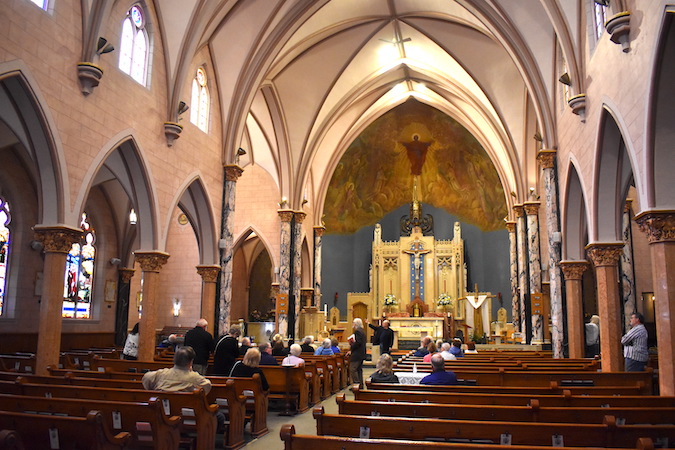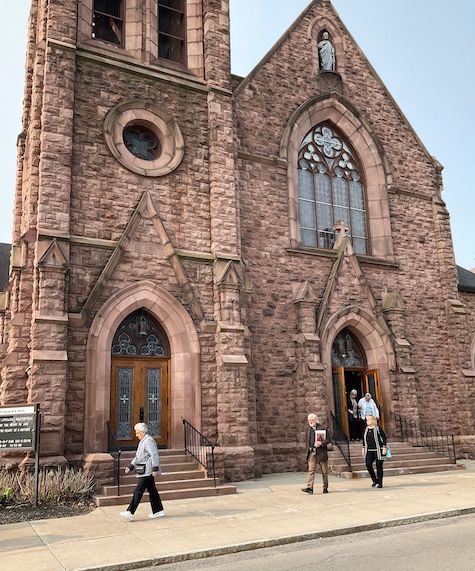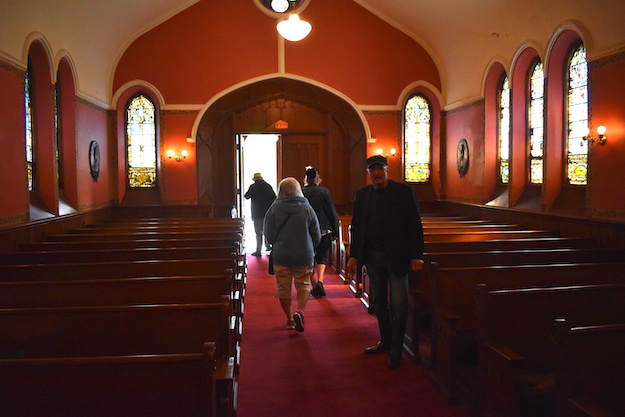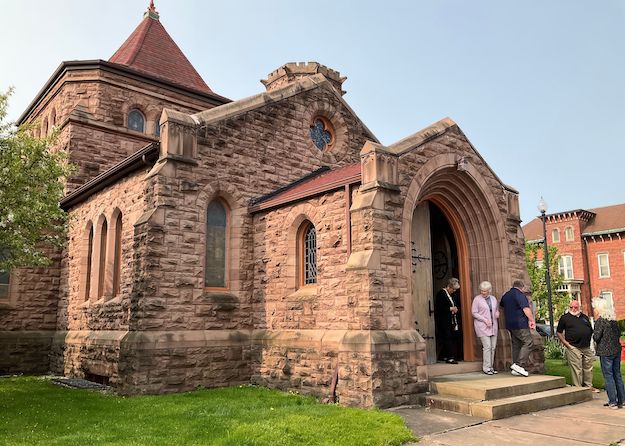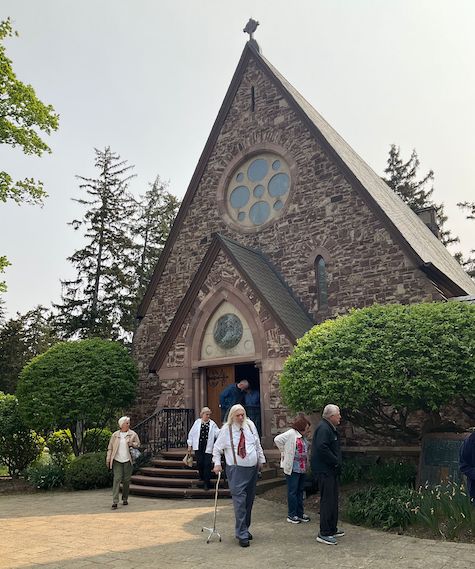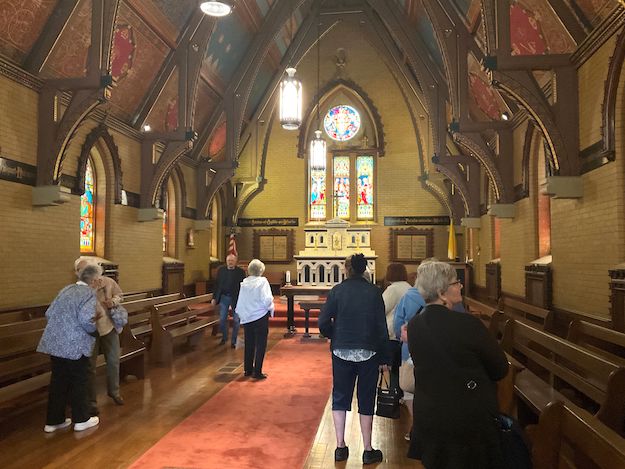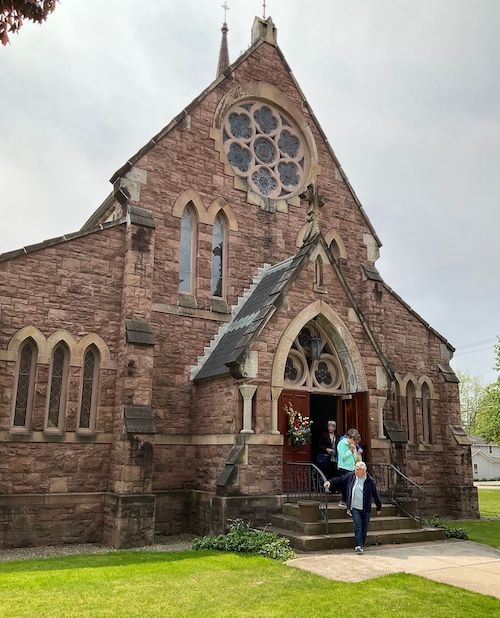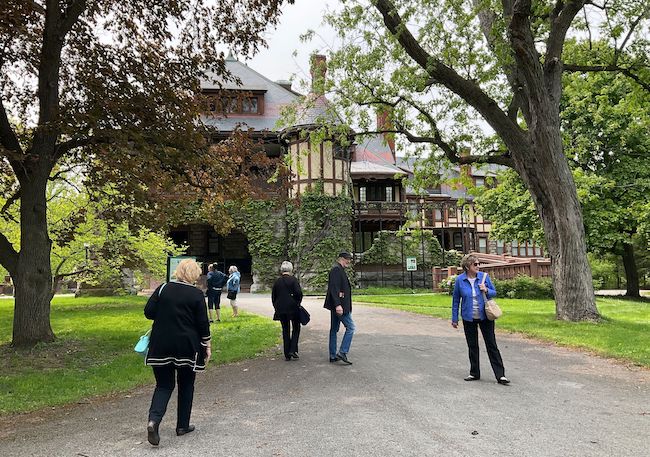Bus tour visits Medina Sandstone Hall of Famers
ALBION – The Medina Sandstone Society took about 40 people on a bus tour last week of sites in the Medina Sandstone Hall of Fame.
The “Sedimental Journey” bus tour returned after being cancelled during the Covid pandemic. The trip started at the Medina Sandstone Hall of Fame which is in the main meeting room at Medina City Hall.
From there the tour headed to Albion to see St. Joseph’s Catholic Church and the Pullman Memorial Universalist Church.
Photo by Dave Miller: Some of the attendees on the Hall of Fame bus tour walk in front of St. Joseph’s Catholic Church.
The church was dedicated in 1897. It was built of locally quarried sandstone in a Gothic Revival style on West Park Street. The sandstone Society last year inducted the church, and that induction included St. Joseph’s School and Lyceum on Main Street in 1905 and the chapel at St. Joseph’s Cemetery on Route 31, which was built in 1920. The lyceum is the first school to be included in the Medina Sandstone Hall of Fame.
Photo by Tom Rivers: Bill Lattin gave the group a peek at the inside of the Pullman Memorial Universalist Church. The church was built in 1894 and has more than 40 windows from the Tiffany Glass and Decorating Company.
Photos by Dave Miller: The Pullman church was among the first inductees into the Medina Sandstone Hall of Fame in 2013. The church was primarily funded by industrialist George M. Pullman, as a memorial to his wife and parents. The building was designed in an Old English Gothic style with Richardson Romanesque features. Its long, low horizontal profile adds to a unique design.
After Albion the tour headed to Rochester to see the Holy Sepulchre Cemetery in Rochester, which was inducted in the Hall of Fame in 2017. The group was able to tour inside the All Soul’s Chapel at the cemetery.
The chapel was built in 1876 and is the centerpiece of the Holy Sepulchre Cemetery. The building features a steep slate roof, supporting hammer beams and exquisitely designed stained-glass windows featuring the 14 Stations of the Cross made in Roemond, Holland.
There is also a companion 100-foot bell tower built in 1886 that houses a six crypt mausoleum, the final resting place for the bishops of the diocese, including Bishop Bernard McQuaid, founder of the cemetery.
The chapel, as well as the two gate houses, and 1.36 mile stone wall surrounding the cemetery are all made of beautifully preserved and restored red Medina sandstone.
The tour also included a drive-by of St. Bernard’s Seminary in Rochester, which was in the inaugural Hall of Fame class in 2013.
After Rochester, the tour headed to Palmyra in Wayne County to see the Zion Episcopal Church, which was inducted into the Hall of Fame in 2019.
The church was built in 1872 in a Late Gothic Revival style, an architectural movement popular in the Western world that began in the late 1740s in England. The church is built of sandstone with limestone trim.
The tour also did a drive-by stop at St. John’s Episcopal in Clifton Springs, which was inducted in 2018.
The tour’s last site was the Sonnenberg Manor in Canandaigua, which was inducted in the Hall of Fame in 2016.
The 40-room Queen Anne style mansion was built in 1887. The facade is rusticated Medina gray and red sandstone. The property is now under the New York State Parks System.
The Sandstone Society will be inducting its 10th anniversary class later this year. For more on the Hall of Fame, click here.





























